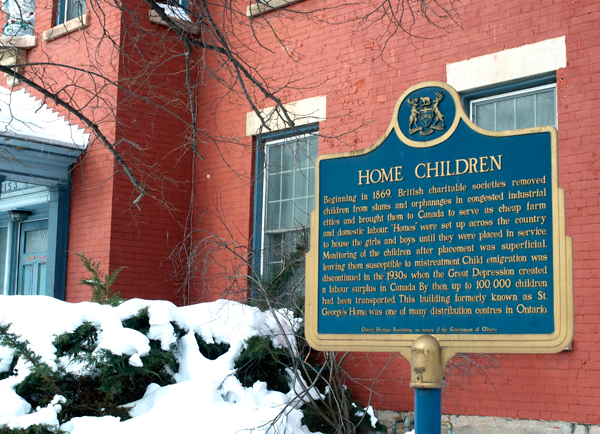Q: I know that St. George’s Home for Boys has been closed for a while, since young boys are not being sent from the U.K. anymore. I would like to know what the house is being used for now. If it is not being used, could it be turned into a hostel or house for some street people in the neighbourhood?
Arthur Chartrand
A: Thank you for your question Arthur. I too have wondered what’s going on with this building, which is located across the street from the Salvation Army Grace Manor on Wellington.
For those who haven’t read the plaque out front, I thought it’d be interesting to share a bit about its history. This building used to be a “distribution centre” for Home Children, which was the term given to British children (sometimes orphans, mostly not) who were sent to Canada to work as cheap labour in farms and as domestic help between 1896 and 1935. Thousands of children passed through these doors.

I asked Dave Allston, a local historian, to see what else he could dig up about this building and find out what it’s being used for today.
There are actually three parts to this building. The oldest is the central portion, which started out as a grand 2 1/2-storey wood-framed home that dates back to at least the 1870s. In 1895, it was acquired by Lord Archibald Douglas, who had been arranging for the emigration and placement of Catholic children from England to Canada since 1882. Douglas hired a well-known Ottawa real estate agent T.W. McDermott to be the first superintendent of the home, which he called “New Orpington Lodge.” McDermott was the agent responsible for the lease and eventual sale of the home to Douglas.
The first group of 30 children arrived in May of 1896. Sometime between 1904 and 1905 the building was renamed St. George’s Home. A report issued by G. Bogue Smart in 1904 described it in this way: “The accommodation at this Home, I regret to say, is not what it should be. The boys’ sleeping quarters consists of one large room in the attic. This room is unfurnished, unplastered, and access to it is had only through a narrow attic stairway. There were some camp beds with mattresses and blankets sufficient to accommodate half a dozen boys, and the balance of the party are obliged to sleep on the floor…” [story continues below]

The home closed in 1935, and it was mostly vacant until 1940 when it was leased to the Navy. It was used primarily for storage during this time, but after the war ended a newspaper reported it was the site of some “highly hush-hush” experiments. Today, the on-site historian says those secret experiments were only water testing, and tells a story of a local Hintonburgian who joined the Navy to see the world but got posted two blocks from his home to guard a water tank on Wellington Street.
St. George’s was also considered a possible site for a “wartime nursery” (in other words, a daycare) because of the increased need for women to join the workforce. Although many women did gain employment outside the home, the building never housed childcare facilities.
In September of 1946, a permit was issued to convert the building to a church. In May of 1947, the Queen of the Most Holy Rosary Parish opened in the building. “Father Phil” Harris acquired a bell, an acquisition which was worthy of a mention in the local paper at the time. As it turns out, the bell was too heavy for the roof and they were never able to install it.
Today, the building continues to operate as the Holy Rosary Parish. The chapel is at the rear (fronting onto Grant) and the rectory and offices are in the middle. The part along Wellington is used as a residence for young missionaries as part of the NET Ministries of Canada program (National Evangelization Teams). Allston has been inside, and says the entire building is definitely being put to good use.
Local history buffs who would like to learn more about Home Children should go to canadianbritishhomechildren.weebly.com. There’s a section about St. George’s too.
Andrea Tomkins,
Editor